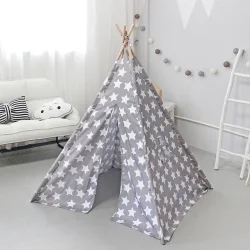Considerations for Choosing a Play Tent
2024-07-08
Play tents are popular and versatile toys that provide children with a fun and imaginative space to play, read, and relax. They come in various shapes, sizes, and themes, catering to different interests and preferences. Here’s an overview of play tents, their features, benefits, and considerations for choosing the right one:
Features
1. Designs and Themes:
- Basic Tents: Simple designs that resemble traditional camping tents.
- Themed Tents: Designed to look like castles, houses, vehicles, or popular cartoon characters.
- Tunnel Tents: Include tunnels connecting multiple sections for added fun.
2. Materials:
- Fabric: Typically made from lightweight, durable materials like polyester or cotton.
- Frame: Made from flexible materials like plastic or metal poles for easy assembly and stability.
3. Portability:
- Pop-Up Tents: Easy to set up and fold down, making them portable and convenient for indoor and outdoor use.
- Foldable Tents: Can be folded into a compact size for storage and transport.
4. Ventilation:
- Mesh Windows: Provide airflow and visibility while keeping insects out.
- Openings: Multiple entry and exit points for easy access and interactive play.
5. Extras:
- Floor Mats: Some play tents come with padded floors for added comfort.
- Accessories: May include flags, lights, or decorative elements to enhance the theme.
Benefits
1. Encourages Imagination:
- Provides a dedicated space for children to engage in imaginative play, fostering creativity and role-playing.
2. Promotes Independence:
- Gives children a sense of their own private space, promoting independence and personal responsibility.
3. Physical Activity:
- Encourages movement and physical activity, especially with designs that include tunnels and obstacle courses.
4. Social Interaction:
- Encourages social skills and cooperative play when shared with siblings or friends.
5. Versatile Use:
- Suitable for various activities such as reading, napping, playing with toys, or even as a quiet space for relaxation.
Considerations for Choosing a Play Tent
1. Size and Space:
- Ensure the tent fits the available space in your home or yard.
- Consider the number of children who will be using it simultaneously.
2. Safety:
- Look for sturdy construction and materials that are free from harmful chemicals.
- Check for secure seams, stable frames, and avoid small parts that could be choking hazards.
3. Ease of Assembly:
- Choose a tent that is easy to set up and take down, especially if it will be moved frequently.
- Pop-up and foldable designs are typically more convenient.
4. Age Appropriateness:
- Select a tent that is suitable for the child’s age and developmental stage.
- Ensure it has adequate ventilation and visibility for younger children.
5. Durability:
- Opt for high-quality materials that can withstand rough play and frequent use.
- Check for reinforced stitching and sturdy frames.
6. Cleaning and Maintenance:
- Choose materials that are easy to clean, such as machine-washable fabrics or wipeable surfaces.
Popular Types of Play Tents
1. Indoor Play Tents:
- Designed for use inside the home, often with softer materials and more decorative elements.
2. Outdoor Play Tents:
- Made from more durable, weather-resistant materials for use in the yard or park.
3. Teepee Tents:
- Feature a triangular shape with a simple frame, often made from natural materials like wood and canvas.
4. Castle and Fortress Tents:
- Themed tents resembling castles or forts, often with turrets, flags, and elaborate designs.
5. Character Tents:
- Based on popular characters or franchises, such as superheroes, princesses, or animated series.
Play tents are a fantastic addition to any child’s playtime, providing endless opportunities for fun, creativity, and learning. By considering the features, benefits, and factors mentioned above, you can choose the perfect play tent to suit your child's needs and preferences.



